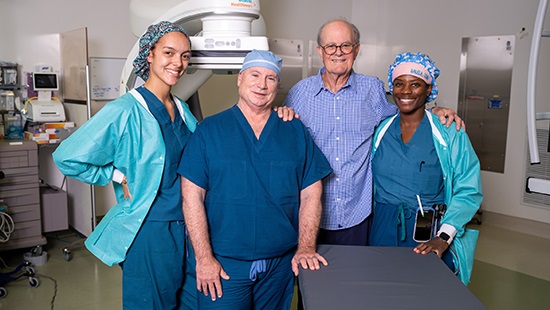Are You at Risk for Vascular Disease?

Get a free, personalized report that helps you understand your risk and gives you next steps to lower that risk.

Jay Miller with members of his surgical care team. From left to right: Isabella Tyson, RT(R); Marshall Benjamin, MD; and Salela Jordan, CRNA.
In 1982, Jay Miller sold UM BWMC its first CT scan technology. Over the next three decades, Miller developed lasting connections with several healthcare providers across the region.
Those providers include Marshall Benjamin, MD, chair of surgical services at UM BWMC and clinical associate professor of surgery at University of Maryland School of Medicine (UM SOM).
Retired since 2014, Miller has always been active. But a couple of years ago, Miller started experiencing back pain and difficulty walking. Not wanting to slow down, Miller talked with his primary care provider, who ordered an MRI scan of his back. He didn’t expect the scan to lead him back to his longtime friend, Dr. Benjamin, for vascular care.
Miller’s MRI scan results showed issues with several discs in his back. But it was the last item on the radiology report that grabbed his attention: Miller had an abdominal aortic aneurysm (AAA).
An AAA is an abnormal bulge in the aorta, the blood vessel that carries blood from the heart to the lower half of the body. An AAA often has no symptoms, but it can cause pain in the abdomen, back, groin or legs.
Due to his previous work in healthcare technology, Miller knew an AAA was life-threatening. Without treatment, the ballooning of the aorta can cause blood to leak into the body or cause the artery to burst. Miller immediately knew what he needed to do.
Miller knew he could trust Dr. Benjamin’s unmatched expertise and called the Vascular Center at UM BWMC.
Dr. Benjamin quickly got Miller into the clinic and ordered a specialized X-ray to get more information about the AAA. The test revealed another concern.
“Jay’s condition was unique,” Dr. Benjamin said. “He had an aneurysm that, by its size and shape, really was a life-threatening issue. He also had two blockages in his groin, one on each side. When we did the ultrasound studies, he had about half of the normal blood flow down in his legs because of those blockages.”
Dr. Benjamin recruited his colleague, David Neschis, MD, vascular surgeon at UM BWMC and clinical associate professor of surgery at UM SOM, to help with Miller’s complex case.
Having worked closely for nearly 25 years, the two surgeons carefully planned out the procedures. To address the AAA, Miller needed to have a stent placed in the aorta to support the walls of the blood vessel. He also needed surgeries to remove the blockages.
Miller was in good hands. In the 1990s, Dr. Benjamin performed the first aortic endograft at the University of Maryland Medical Center in Baltimore. This was also one of the first endografts done in Maryland. A few years later, Dr. Benjamin brought this technology to UM BWMC and developed the vascular surgery department.
During his surgical training in Pennsylvania in the 1990s, Dr. Neschis was also on the forefront of endovascular innovation and brought that expertise to UM BWMC in 2000.
Dr. Benjamin and Dr. Neschis, along with specialists at the Vascular Center at UM BWMC, have treated over 1,000 cases of AAA since its opening in 2002. The team was well prepared to handle a complex case such as Miller’s.
Miller was brought into the operating room. In addition to Dr. Benjamin and Dr. Neschis, the team included an anesthesiologist, nurses, physician assistants, surgical technicians, X-ray technicians, and surgical residents and fellows.
Each surgeon successfully removed one of the blockages and then worked together on the stent. The surgery went as planned.
Dr. Benjamin came by Miller’s hospital bed the next morning to check on him. Miller learned that the combination of AAA and peripheral arterial disease made his case more challenging than usual.
Miller went home from the hospital just two days after surgery. For a few months, he followed post-surgery precautions that limited how much he could lift. Now, he is doing well and staying as active as he can.
Reflecting on his surgery and recovery, Miller knew the caliber of compassionate care at UM BWMC is unparalleled.
“I received great care from the surgeons, physician assistants, nurse practitioners, everybody,” Miller said. “They treated me like family. They saved my life.”

Get a free, personalized report that helps you understand your risk and gives you next steps to lower that risk.